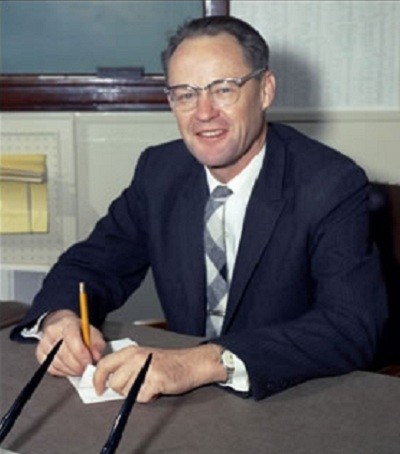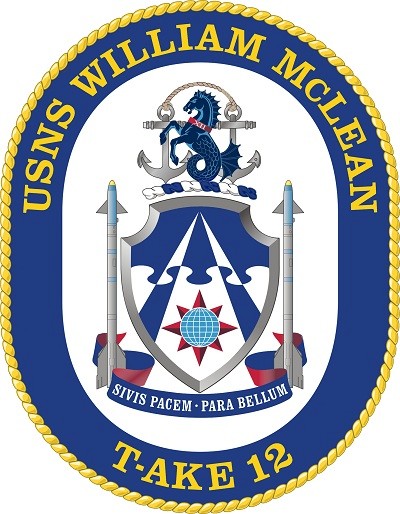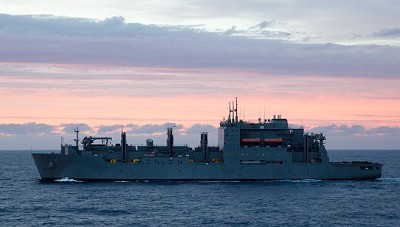William McLean (T-AKE-12)
2011–
William Burdette McLean, born in Portland, Or., on 21 May 1914, was descended from a line of Presbyterian ministers including his father, brother, and both grandfathers, paternal and maternal. His family relocated to Dubuque, La., shortly after his birth, and in 1919 to Eagle Rock, near Los Angeles, Calif. Both of his parents proved mechanically inclined and so influenced their son. “My mother,” he reminisced, “taught me to knit, crochet, and use the sewing machine before I went to kindergarten…My father showed me how to repair automobiles, build homes, and do plumbing and electrical wiring. Everything that broke became a challenge to figure out how to repair it and make it better.”
McLean completed his primary and secondary education in the Los Angeles area. He subsequently observed that his love of the sea began during this period, when his father purchased a house at the beach in Newport, Calif., in 1927. The young man spent his next four summers learning about surfing, canoeing, and rafting. McLean entered the California Institute of Technology, Pasadena, Calif., to study electrical engineering, in 1931. The following year, he transferred his major course of study to physics. While he studied, his family moved to Santa Barbara, but he continued his classes at Pasadena, and attained a B.S. in 1935, an M.S. in 1937, and a Ph.D. in 1939. His graduate work included assisting Dr. Charles C. Lauritsen and Dr. Willy Fowler while they constructed a half-million-volt Van der Graaff generator, which used a moving belt to accumulate high amounts of electrical potential on a hollow metal globe on the top of a stand. McLean also supported himself by working in a photographic laboratory, from which he gained a lifelong interest in photography. During this period, however, he tragically developed diabetes.
Shortly after McLean attained his doctorate, he married Edith LaVerne Jones. She shared his interest in the church, and enjoyed scuba diving. Their union ultimately produced two sons. They moved to Iowa City, Iowa, where he worked in alpha particle counters during a postdoctoral fellowship (1939–41). Following the United States’ entry into World War II, the McLeans wanted to support the war effort and relocated so that he could work at the National Bureau of Standards in Washington, D.C. McLean worked primarily on proximity fuses, though he also worked on the research and development of rockets, fire control systems, acceleration integrators, and arming devices.
Dr. Louis T. E. Thompson, a physicist who worked at the Naval Ordnance Test Station (NOTS) at Inyokern (later China Lake), Calif., knew of McLean’s interest in experimentation and invited him to join him. McLean arrived there on 5 July 1945. While at NOTS, he led the project team that developed the AIM-9 Sidewinder heat-seeking air-to-air missile, which uses infrared radiation from the target aircraft as its source of guidance information. McLean stressed simplicity and ease of maintenance in the design. The Navy fired the first fully configured AAM-N-7 Sidewinder I on 3 September 1952. The Sidewinder I made its first successful interception when a missile shot down a Grumman F6F Hellcat drone on 11 September 1953. In April 1954, he was appointed technical director, the senior civilian position at NOTS. Two years later, Adm. Arleigh A. Burke, the Chief of Naval Operations, presented McLean a Navy award of $25,000 and a plaque from President Dwight D. Eisenhower in recognition of his crucial work on the Sidewinder. Meanwhile, throughout McLean’s endeavors at Inyokern, his wife gained a reputation for her gracious hospitality to people.

McLean works at his desk while serving as the technical director of the Naval Ordnance Test Station, China Lake, Calif., November 1960. (News Release Number ECL200812031, Naval Air Warfare Center Weapons Division, Public Affairs Department)
McLean’s boundless curiosity propelled him to build a shop in his home where he often worked on additional projects. He also shared his wife’s passion for scuba diving, and designed his own wet suit and pressure regulator. McLean headed the newly-established Naval Undersea Warfare Center at San Diego in 1967. He increasingly emphasized the sea in his experiments, and used his swimming pool for some of his tests. He also enjoyed open-sea boating. His health deteriorated during this time frame, however, and in addition to struggling with diabetes, he suffered a heart attack in 1968, and required two surgeries for cataracts in 1967 and 1969. In 1968, the Navy established the award for Dr. William B. McLean to recognize creativity in employees who furthered the mission at China Lake with significant inventions. McLean retired in 1974 and died on 25 August 1976. Edith McLean died at her home in San Diego in the early afternoon of 19 December 2007.
(T-AKE-12: displacement 42,528; length 689'; beam 106'; draft 30'; speed 20 knots; complement 197; armament up to 6 .50 caliber or 7.62 millimeter machine guns and two Sikorsky MH-60S Knighthawks or two Eurocopter (Aérospatiale) AS332 Super Pumas; cl. Lewis and Clark)
William McLean (T-AKE-12) was laid down on 23 March 2010 at San Diego, Calif., by General Dynamics National Steel and Shipbuilding Co.; launched on 16 April 2011; sponsored by Mrs. Margaret Taylor, niece of the late Dr. McLean; and was placed in service with the Military Sealift Command on 28 September 2011.

Shield
Dark blue and gold are the colors traditionally used by the Navy. Gold is also emblematic of honor and high achievement. Blue and white echo the colors of the sea. The nebuly partition line is intended to look like clouds as depicted in heraldry. The two narrow pointed wedge shapes with points going up through the clouds allude to two launched missiles locking in on their target. The counterchanged colors stand for unity and cooperation. The clouds and sky also refer to the aviation capabilities of William McLean. The compass rose and globe emphasize the world wide mission of the auxiliary dry cargo ship. The thick steel border denotes strength and resolve.
Crest
The anchors, symbols of sea prowess, with the ship being represented by one and the other, the U.S. naval forces. The rope connecting them signifies receiving the steady flow of cargo and ammunition from the auxiliary dry cargo ship. The seahorse, strong and dependable, personifies William McLean’s being a work horse to the fleet, providing a steady, secure stream of dry cargo and ammunition. The red of the collar inscribed with XII stands for the zeal and bravery of the mariners on board William McLean and the sailors and marines she services.
Supporters
The AIM-9 Sidewinders commemorate William McLean, the physicist who conceived and developed the heat-seeking air-to-air missiles.

William McLean emergency sortied in advance of Hurricane Sandy from Norfolk, Va. (late October–early November 2012).
Detailed history under construction.
Mark L. Evans
24 January 2014


